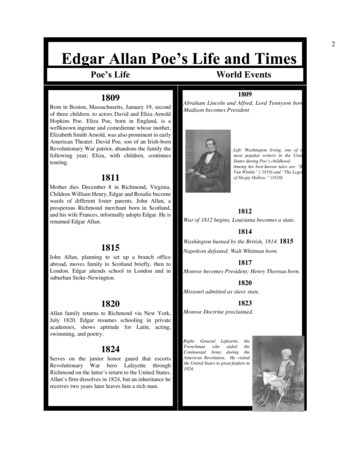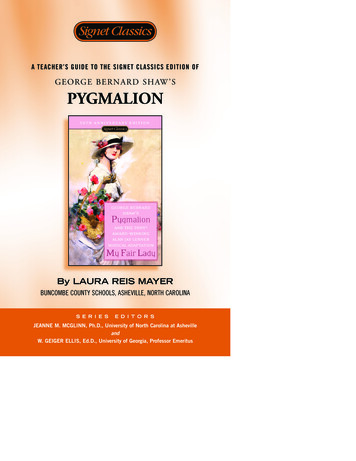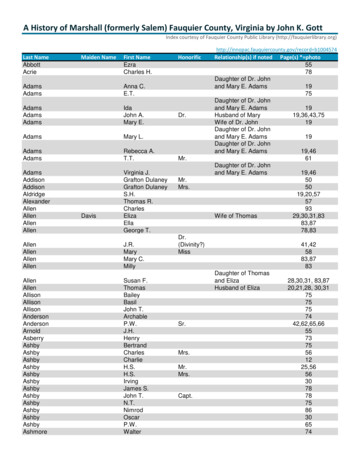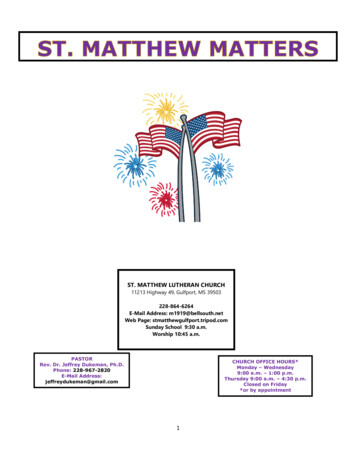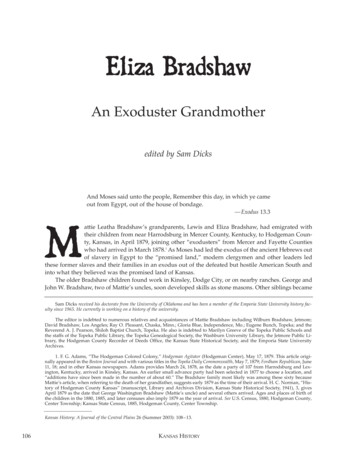
Transcription
Eliza BradshawAn Exoduster Grandmotheredited by Sam DicksAnd Moses said unto the people, Remember this day, in which ye cameout from Egypt, out of the house of bondage.—Exodus 13.3attie Leatha Bradshaw’s grandparents, Lewis and Eliza Bradshaw, had emigrated withtheir children from near Harrodsburg in Mercer County, Kentucky, to Hodgeman County, Kansas, in April 1879, joining other “exodusters” from Mercer and Fayette Countieswho had arrived in March 1878.1 As Moses had led the exodus of the ancient Hebrews outof slavery in Egypt to the “promised land,” modern clergymen and other leaders ledthese former slaves and their families in an exodus out of the defeated but hostile American South andinto what they believed was the promised land of Kansas.The older Bradshaw children found work in Kinsley, Dodge City, or on nearby ranches. George andJohn W. Bradshaw, two of Mattie’s uncles, soon developed skills as stone masons. Other siblings becameMSam Dicks received his doctorate from the University of Oklahoma and has been a member of the Emporia State University history faculty since 1965. He currently is working on a history of the university.The editor is indebted to numerous relatives and acquaintances of Mattie Bradshaw including Wilburn Bradshaw, Jetmore;David Bradshaw, Los Angeles; Ray O. Pleasant, Chaska, Minn.; Gloria Blue, Independence, Mo.; Eugene Bunch, Topeka; and theReverend A. J. Pearson, Shiloh Baptist Church, Topeka. He also is indebted to Marilyn Greeve of the Topeka Public Schools andthe staffs of the Topeka Public Library, the Topeka Genealogical Society, the Washburn University Library, the Jetmore Public Library, the Hodgeman County Recorder of Deeds Office, the Kansas State Historical Society, and the Emporia State UniversityArchives.1. F. G. Adams, “The Hodgeman Colored Colony,” Hodgeman Agitator (Hodgeman Center), May 17, 1879. This article originally appeared in the Boston Journal and with various titles in the Topeka Daily Commonwealth, May 7, 1879; Fordham Republican, June11, 18; and in other Kansas newspapers. Adams provides March 24, 1878, as the date a party of 107 from Harrodsburg and Lexington, Kentucky, arrived in Kinsley, Kansas. An earlier small advance party had been selected in 1877 to choose a location, and“additions have since been made in the number of about 60.” The Bradshaw family most likely was among these sixty becauseMattie’s article, when referring to the death of her grandfather, suggests early 1879 as the time of their arrival. H. C. Norman, “History of Hodgeman County Kansas” (manuscript, Library and Archives Division, Kansas State Historical Society, 1941), 3, givesApril 1879 as the date that George Washington Bradshaw (Mattie’s uncle) and several others arrived. Ages and places of birth ofthe children in the 1880, 1885, and later censuses also imply 1879 as the year of arrival. See U.S. Census, 1880, Hodgeman County,Center Township; Kansas State Census, 1885, Hodgeman County, Center Township.Kansas History: A Journal of the Central Plains 26 (Summer 2003): 108 – 13.106KANSAS HISTORY
Mattie Bradshaw, ca. 1907.
blacksmiths, mechanics, or practiced other trades to survive and support their families. These labors provided income during periods of low farm prices and of drought ina harsh climate.Mattie was almost ten years old when her parents,Charles T. and Mary Elizabeth Bradshaw, moved fromHodgeman County, in southwestern Kansas, to Topeka inabout 1897 so their children might have an education beyond elementary school. Her father at first worked as afruit peddler and later as a janitor at the state capitol. Mat-attained her seventh year, she was sold to another planter.The little girl experienced her first trials and hardships ather new home. Surely the institution of slavery was themost cruel and heartless invention of man, as it separatedthe child from her mother, whom she never saw again.When I think of the agony which the mother must havefelt, tears unbidden stream down my cheeks. Grandmanever knew her father, for she never saw him. He wouldnot own her because she was born black side out, while hewas born black side in.3 There is a chance for cleanlinessEarly one cold December morning, on a large plantation inMercer county, Kentucky, a girl baby first saw the light ofday. She was born of slave parents, in the utmost poverty.tie graduated from Topeka High School in 1905 and received a Life Teaching Certificate from the Kansas StateNormal School (now Emporia State University) in 1908.While student teaching at the campus Model School inthe fall of 1907, she wrote the following story, which appeared on October 18 in the student newspaper, the StateNormal Bulletin.2MY GRANDMOTHER’S STORYby Mattie BradshawEarly one cold December morning [in 1827], on alarge plantation in Mercer county, Kentucky, a girlbaby first saw the light of day. She was born ofslave parents, in the utmost poverty and wretchedness.The little cabin hut, which was her first home, containedone room in which there were no openings or windows,save the one door. There a large family of children werereared, of which grandma was the sixth.The first few years of her life passed pleasantly andquickly away. Finally, one bright morning when she had2. Black student teachers commonly did their student teaching onthe campus, rather than in community public schools, in order to avoidparent objections.108when blackness is external, but when it has penetrated beneath the surface, far beyond the range of human vision,there is hardly a chance for purification.But to proceed with my story, Grandma remained withher new owners for seven or eight years. At this plantationshe was treated as a human being, for her mistress wasgood and even kind to her. She pitied the sad-faced looking little girl, therefore she would not let her go into thefields to work, but taught her to do the sewing. Grandmawas a good pupil and learned to sew well. This she neverregretted, for by means of this trade she earned enough tosupport her family in later days.However, this kind of life did not last long. Suddenlya reverse of fortune came to Mr. Lewis, her owner.4 A manwhom he owed pressed him for the payment of a debt.3. Although Mattie wrote that her grandmother was “born of slaveparents,” she suggests here that the white slaveholder who took her fromher mother and sold her was her biological father, a practice not uncommon during slavery. Eliza is identified as a mulatto rather than a black inthe 1880 federal census and the 1895 Kansas census. See U.S. Census, 1880,Hodgeman County, Center Township; Kansas State Census, 1895, Hodgeman County, Center Township.4. J. A. Lewis is listed on the U.S. Census, 1830, Kentucky, MercerCounty, with the following slaves: males, two under 10 years of age, one10 – 24, one 24 – 35, one 36 – 54; females, four under 10, two 10–24, and two24 – 36.KANSAS HISTORY
Grandma’s heart was nearly broken when she heard thatshe must leave her kind mistress, but her woe amounted tonothing when a planter said that he would give a coldthousand for her. She was sold. Her new master was one ofthe most unprincipled, degraded and demon-like beingsthat ever bore the name of man. Her mistress was crueland hateful. Grandma soon learned what slavery meant.As she was now about seventeen years old, as was thecustom then, her owners began to think of finding her ahusband. Therefore, after she had been on this plantationkettle of boiling water from the stove and began throwingwater. The slave driver was glad to leave her alone.On the same day she was given a great many tasks toperform. When she was too weary to move another step,she sat down to rest. While she was resting, her mistresscame in the kitchen and demanded to know if the workwas done. On being told that it was not finished, sheseized a broomstick and beat grandma on the top of thehead until streams of blood oozed down her face, then shesprinkled salt on the wounds. Not satisfied with that, sheHer mistress came in the kitchen and demanded to know ifthe work was done. On being told that it was not finished,she seized a broomstick and beat grandma on top of the head.about three months she was married to another slave onthe same plantation. The ceremony consisted only of thereading of a passage of scripture by a local preacher andthen the pair were pronounced husband and wife. Thiswas the only ceremony that was performed when slavesmarried.To this union were born seven sons and two daughters. All were born in slavery.5 When the oldest child wasfive years old, he had to take care of two younger children.One day he took the youngest child and went up to the“big house” to see his mother. The slave driver saw himand began to meddle, and when the child said somethingthat made him angry, he knocked the little fellow down.Grandma, on hearing the confusion, stepped to the doorand began to interfere in behalf of her child. As the slavedriver started towards her with whip in hand she seized a5. The sons and their ages in the 1870 U.S. Census for Mercer County, Kentucky (Precinct 6), were John W. 20, Granville 17, Lewis D. 14,Charles T. (Mattie’s father) 12, Elex 8, George W. 7, and Benjamin F. 3. Benjamin was born after the abolishment of slavery. For enumeration of mostfamily members after their arrival in Kansas, see U.S. Census, 1880,Hodgeman County, Center Township; Kansas State Census, 1885, Hodgeman County, Center Township. Lewis, age 24, is a cook, and George, age17, is washing dishes at a Dodge City hotel according to the 1880 census.See ibid., Ford County, Dodge Township. Granville, age 27, is a “hustler”(peddler) in Kinsley in 1880. See ibid., Edwards County, Kinsley.told her husband when he came home. Grandma heardMr. Christian, for that was her owner’s name, say that hewould whip her when supper was over.6 She made up hermind that she had been treated cruelly enough that day,and she said within herself that she had taken her lastwhipping. She made up a hot fire and put on a larger kettle of water, so when Mr. Christian came in the kitchen andtook down the rawhide, she smiled, for she knew that helittle expected what was coming. When he started towardsher she dipped her little bucket in the boiling kettle andbegan throwing water in every direction. She scalded Mr.Christian’s hands and feet, also Mrs. Christian’s face. Afterthat incident grandma was called “Crazy Eliza,” but sheonly smiled to herself whenever she was called by thatname, for she was willing to be thought crazy if it wouldsave her from being punished. She was never whippedagain.6. The surname Christian does not appear in the 1840, 1850, or 1860federal censuses of Mercer County, but it appears frequently in the censuses for adjacent Fayette County. See U.S. Census, 1840, Kentucky, Mercer County and Fayette County; ibid., 1850; ibid., 1860. One of the largerslaveholders in Fayette County, according to the 1850 federal censusslave schedule, was Thomas Christian. He, or other family members, mayhave held land and slaves in both counties. According to family tradition,the surname Bradshaw was chosen upon emancipation, rather thanChristian, because, unlike the Christian family, slaveholding members ofthe Bradshaw family treated their slaves well. David Bradshaw, interviewby author, March 20, 2003.ELIZA BRADSHAW109
When she had endured cruelties and indignities forthirty years, one morning she awoke to find that she wasfree. President Lincoln had issued the EmancipationProclamation.7 No more was she to be beaten and knockedabout by dealers in human traffic. She could now say thatthe songs which she sang meant freedom of body in thisworld as well as freedom of spirit in the world of light. Shewas free, but what did she receive for her labors? She hadbeen in slavery forty years. Her best days were spent. Shehad no money; she had nowhere to lay her head. For fortyyears. They forgot that these same black men tilled the soilwith their horny hands and watered it with their tears ofhumiliation. By some means the ex-slaves heard of a landwhere people of color were better treated. They heard thatthey could get a free education and would be protected bythe laws, so when at last these would be marauders became so cruel and oppressive, my people began to emigrate to the so-called “land of the blest.”8Thus, while so many members of my race were emigrating, grandma struck the soil of “free and bleedingWhen she had endured cruelties and indignities for thirtyyears, one morning she awoke to find that she was free. President Lincoln had issued the Emancipation Proclamation.years her labor enriched the treasury of another race. Shemust now fight the battle for existence.The first few years of freedom looked dark to the people of color. Grandma’s first ambition was to give her children an education. She thought that if they could read andfigure they could “make it” in the world. Accordingly, shesacrificed as only a mother would to give her children aneducation; therefore, the older children went to schoolabout three months in a year for three years. Then theirhopes were shattered almost beyond redemption. WhiteHorse gangs and Ku Klux Klans paraded the state of Kentucky, burned down their school houses, drove the negroesfrom home, and burned some at the stake. The state ofKentucky offered the men of color no protection. They (thewhite race) soon forgot the faithful service of the negroeswho had been their servants for two hundred and fifty7. The Emancipation Proclamation, which went into effect on January 1, 1863, applied only to slaves in those states that had seceded fromthe Union and were not under Northern military control. Slavery remained legal in Kentucky until it was abolished by the ratification of thethirteenth amendment to the Constitution on December 6, 1865. However, it is easy to understand how Mattie Bradshaw and others thought of itas the document proclaiming the freedom of all slaves, for the Emancipation Proclamation did apply to most exodusters migrating from Southernstates and was the symbol of freedom in the minds of virtually all formerslaves and their families in the years following the Civil War.110Kansas.” She was accompanied by her husband, six sonsand two daughters. They immediately moved to Hodgeman county, where grandfather took up a homestead.After they were there about six months grandfather finished his work on earth and went to answer the roll-call ofdeath.9 Soon “hard times” began. They were in a newcountry, sparsely populated and with arid soil. Grandmahad a hard time. Twice the first winter they thought theywould have to give up, but they did not yield, for the privations were nothing compared to the persecutions andoppressions endured in the southlands. Many times theywore “gunny” sacks around their feet in place of shoes.Frequently they ate bread made of bran, but they called noman “master.”After a few years she and her sons were in fairly goodcircumstances. Four of her sons, including my father, hadtaken a quarter section of land each, and had begun to till8. For more details on the exoduster migration to Hodgeman County, see C. Robert Haywood, “The Hodgeman County Colony,” Kansas History: A Journal of the Central Plains 12 (Winter 1989): 210 –21. Early sourcesinclude Adams, “The Hodgeman Colored Colony”; Mrs. M. L. Sterrett,“Negro Colony Among Early Settlers of Hodgeman County,” Jetmore Republican, April 25, 1930; Norman, History of Hodgeman County Kansas.9. Lewis Bradshaw died of consumption (tuberculosis) at age fiftythree in August 1879. See U.S. Census, 1880, Hodgeman County, Mortality Schedule.KANSAS HISTORY
the soil with quite a degree of success.10 The last twentyyears of grandma’s life have been years of pleasure. Shehas not worked for her support, but is enjoying her life asshe could not in her early years. She has numerous grandchildren who always hold open doors for her. Nothing istoo good to give her nor is any task too hard to perform forher.Grandma is now eighty-two years old. She did nothave a great estate to give us, because when she was ableto work her labor went unrewarded to replenish the pos-Washington Schools. From 1916 to 1924 she taught inBuchanan School, and from 1924 to 1933 in MonroeSchool.11Mattie’s younger sister, Maytie Bradshaw Williams(1899–1967), also became a teacher at Washington Schoolin Topeka, and her brother, William Bradshaw (1897–1947), graduated from Washburn Law School in 1920 to become a prominent civil rights attorney in the capital city.Both Mattie and William held leadership positions on thestate and national boards and committees of the NationalThe last twenty years of grandma’s life have been years ofpleasure. She has not worked for her support, but is enjoying her life as she could not in her early years.sessions of another race, but she has given us her love. Shehas outlived her days of activity, but we love her still.Eliza Bradshaw (1827–1913) never learned how toread or write, yet she lived to see her granddaughter, Mattie Leatha Bradshaw (1888–1956), graduatefrom college in June 1908 and become a teacher. After earning a Life Teaching Certificate from the Kansas State Normal School, Mattie returned to the home of her parents at1547 Quincy Avenue in Topeka, and began her teaching career in the city’s segregated schools. She taught in MadisonSchool from 1908 to 1915, and during the 1915–1916 schoolyear she held a split appointment between Monroe and10. In addition to the grandparents and Mattie’s father, John W.,George W., and Granville Bradshaw held United States patents on 160 ormore acres of land. Some of their lands were passed on to their descendents. Paul and Wilburn Bradshaw, grandsons of George WashingtonBradshaw, are among the landowners who still farm in the area in 2003.See Land Records, Hodgeman County Register of Deeds, County Courthouse, Jetmore, Kans.; Wilburn Bradshaw, interview by author, February21, 2003; Amy Bickel, “Keeping the History: Family’s Ancestors wereamong Black Hodgeman Co. Settlers,” Hutchinson News, February 16,2003.Baptist Convention and were active lay leaders in Topeka’sShiloh Baptist Church.12Mattie resigned from the Topeka Public Schools, aftertwenty-five years of teaching, in August 1933. The superintendent of schools, A. J. Stout, wrote her, “I am sorry tolose you from the system as I liked your work and felt youwere giving an excellent service. I wish you every happiness.”13 In later years, in addition to her church activities,she was a case worker for the Shawnee County Welfare Department.14Members of the Bradshaw family, beginning with thegrandmother, supported education for their children, aswell as their learning practical skills and trades. Their stories of success are true, not only of Mattie and her sisterand brother but also of many cousins and other familymembers, from their years in Mercer County, Kentucky, tothe present in Kansas and throughout the world. The Bradshaws endured slavery, drought, poverty, segregation, andprejudice. They never gave up.11. Payroll Records, Human Resources Department, Topeka PublicSchools, Topeka; Record of Training and Experience, 1908– 1933, ibid.12. “William Bradshaw Dies Unexpectedly,” Topeka State Journal, February 5, 1947.13. A. J. Stout to Mattie Bradshaw, August 1, 1933, Human Resources,Department, Topeka Public Schools.14. Topeka City Directories, 1938 and later.ELIZA BRADSHAW111
Reverend A. J. Pearson, Shiloh Baptist Church, Topeka. He also is indebted to Marilyn Greeve of the Topeka Public Schools and the staffs of the Topeka Public Library, the Topeka Genealogical Society, the Washburn University Library, the Jetmore Public Li- . April 1879 as the date that George Washington Bradshaw (Mattie's uncle) and several .




